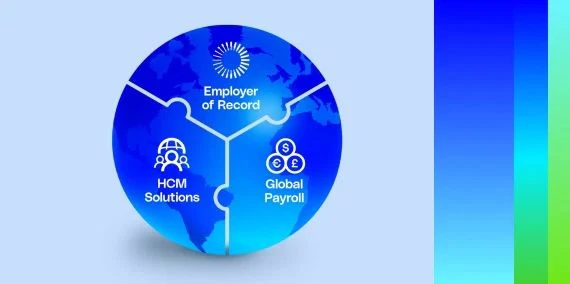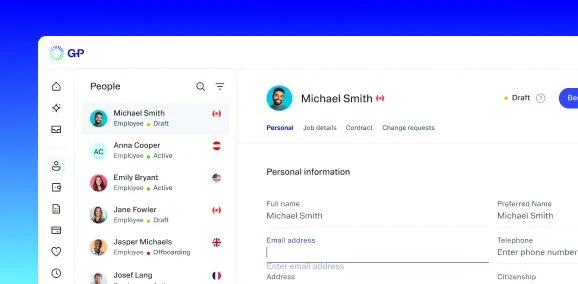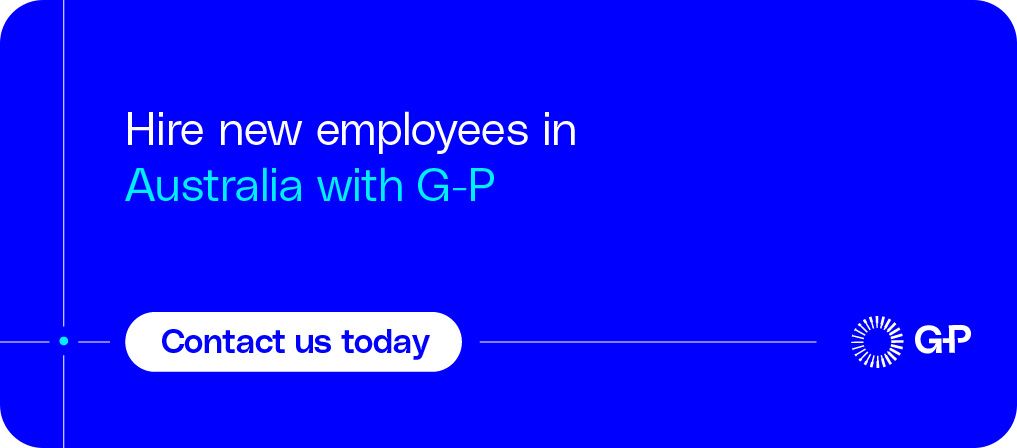Located in the South Pacific, Australia has trade access to major markets like China, India, Singapore, and Japan. Its time zones also overlap with the U.S. West Coast.
Before tapping into the country’s skilled talent pool of engineers, finance professionals, and tech specialists, you’ll need a solid understanding of contract requirements, taxes, and other employment considerations. Our guide will tell you everything you need to know about hiring in Australia.
What to know before hiring in Australia

If you’re expanding your business into Australia for the first time, there are important legal requirements to be aware of. These norms and laws influence hiring practices in Australia and many aspects of the employer-employee relationship, including compensation and benefits.
If you’re unsure where to begin, G-P Gia™, our AI-powered global HR agent, can answer your toughest compliance questions across 50 countries — including Australia — and all 50 U.S. states. Reduce your reliance on outside counsel and cut the time and cost of compliance by up to 95% with Gia.
Let’s take a look at five things to know about hiring in Australia.
1. Language diversity
Australia doesn’t have an official language, but English is the most widely spoken language and the default language for most businesses.
According to the 2021 census, 22% of Australia’s population speaks a language other than English at home. This was an increase from 20.6% in 2016. Common second languages include Mandarin, Arabic, Cantonese, and Vietnamese. The variety of languages in Australia is indicative of the country’s diversity. If you need your Australia employees to be fluent in English or another language, you should specify that in your job ad.
2. Awards, enterprise agreements, and contracts
In Australia, the National Employment Standard provides a baseline for employment law, but most employment terms in Australia are prescribed by modern awards, enterprise agreements, and individual employment contracts.
-
Modern awards: Modern awards, often shortened to “awards,” are legal documents that outline the minimum pay and other requirements for workers by job type and industry. With 122 awards in the Fair Work system, most workers in Australia are covered under an award.
-
Enterprise agreements: In many cases, employees are covered by enterprise agreements, which replace awards if they provide greater benefits than the award. Employers and employees — and sometimes unions — create enterprise agreements. The Fair Work Commission votes on and approves these negotiated agreements.
-
Employment contracts: Employees who aren’t covered by an award or enterprise agreement should instead have an employment contract, which details the terms and conditions of their employment. Employers can create employment contracts for employees covered by awards or enterprise agreements, but these contracts can’t take away anything employees are entitled to under their award or enterprise agreement.
G-P EOR has an Employment Contact Generator to help you draft compliant employment contracts that meet all legal requirements and best practices in Australia.
3. Minimum pay and maximum working hours
Australia has a national minimum wage of AUD 24.94 per hour. However, modern awards dictate employees’ minimum pay in most cases. These legal documents determine what employees should be paid, depending on their position and industry. If an employee is covered by a modern award, you must follow the minimum wage dictated by the award rather than the national minimum wage.
Australian law limits the workweek to 38 hours, though some exceptions are allowed. It’s up to employers to determine how these hours are distributed across the week, but in most cases, employees work Monday through Friday. Overtime hours and rates depend on the award that applies to the employee.
4. Taxes and superannuation
Australia uses a pay-as-you-go (PAYG) system for income tax. This means employers must withhold taxes from employees’ paychecks and remit them to the Australian Taxation Office (ATO). The tax rate depends on compensation levels.
Each state in Australia has its own payroll tax. Employees contribute 2% of their taxable income for Medicare, the nation’s public health insurance scheme. When considering these costs, remember you can streamline the entire employee lifecycle — including payroll — for your team members in Australia with G-P EOR. Pay your global teams in 150 currencies and easily add bonuses, commissions, and exceptions in just a few clicks.
Since July 2022, all employees are entitled to superannuation contributions from their employers. This is the retirement savings plan in Australia, often shortened to “super.” On a quarterly basis, employers must contribute an amount equal to at least 12% of the employee’s income. Employees can also contribute to their fund.
5. Required leave and paid holidays
According to the National Employment Standards, part-time and full-time employees must receive four weeks of paid annual leave, commonly called holiday pay. This is a baseline requirement, but awards or enterprise agreements may require more than this amount. Many employees receive five or six weeks. Companies should pay employees according to their current base pay rate when they take leave. If an employee ends the year with unused leave, they can carry it over to the next year.
Sick leave and carer’s leave are grouped under the umbrella of personal leave. Under National Employment Standards, full-time employees get 10 days of personal leave for sickness, injury, to care for a family member, or to handle a family emergency. Part-time employees are also entitled to personal leave, which is calculated according to how many hours they work.
Employees are entitled to paid days off during public holidays, including the following:
-
New Year’s Day
-
Australia Day
-
Good Friday
-
Easter Monday
-
Anzac Day
-
The Queen’s birthday
-
Christmas Day
-
Boxing Day
A state or territory may have its own holidays to add to the list, such as Labor Day. You can easily administer benefits plans with G-P EOR. Our in-house experts continuously monitor employment laws to meet country-specific regulations and norms. Build and manage benefits plans through our platform to provide a smooth employee experience.
Top hiring hubs in Australia
Some Australian cities are known for particular industries. Knowing what each city has to offer can help you channel your hiring efforts to the right place and fill roles faster.
The top talent hubs in Australia are:
-
Sydney is the largest city and a key finance, business, and technology center. If you're looking for fintech experts, digital marketers, or banking professionals, Sydney has the largest and most experienced talent pool.
-
Melbourne is consistently ranked among the world's most livable cities. It has a diverse economy and strong tech, finance, and creative industries, making it ideal for roles in biotech, university research, or design.
-
Brisbane is a growing hub for business, mineral resources — including cobalt, vanadium, titanium, graphite, and rare earth elements — and technology. As Australia's third-largest city, Brisbane has a strong university presence and a more affordable cost of living than Sydney and Melbourne.
-
Perth has a highly specialized talent pool in resources and energy. It’s known for mining, iron ore, oil, gas, gold, alumina, nickel, copper, lead, and zinc. While it's a geographically isolated major city, it plays a critical role in Australia's economy.
-
Adelaide is smaller than the eastern seaboard capitals but offers unique advantages, particularly in niche high-tech sectors, like space technology, driven by government investment.
Canberra has a high concentration of government, cybersecurity, and public sector talent that can’t be found in the same concentration elsewhere in Australia.
Key industries in Australia
Understanding Australia’s main industries helps you benchmark salaries and benefits. You can use this insight to make smart choices about where to invest and grow your workforce.
The main industries in Australia include:
-
Mining and resources: Australia is a global leader in mining, with significant employment in minerals, oil, and gas. Mining is one of the country's most important industries. It accounts for 10.4% of Australia's GDP. Specialist talent includes engineers, geologists, and skilled tradespeople.
-
Construction: Construction is a major sector in Australia, and creates jobs in residential, commercial, and infrastructure projects. About 1.35 M people work in this field. Specialist talent includes skilled trades, heavy equipment operators, and engineers.
-
Financial and insurance services: Banking, insurance, and investment services are mainly found in big cities. Sydney and Melbourne are home to major banks, investment firms, and insurance companies. Median earnings in this industry are higher than the average for all industries in Australia. Specialist talent includes cybersecurity, fintech developers, and financial planning.
-
Manufacturing: Australia’s manufacturing industry has become more specialized, focusing on high-value, advanced manufacturing. It employs around 900,000 people. Specialist talent includes structural steel and welding workers, metal fitters, machinists, and fabricators.
Agriculture: Given the country’s large landmass and diverse climates, Australian agriculture produces a wide range of food. Agriculture is a key sector in rural areas, covering farming, livestock, and agribusiness. About 70% of what’s produced is exported. Specialist talent includes food scientists, veterinarians, and crop scientists.
The cost of hiring an employee in Australia
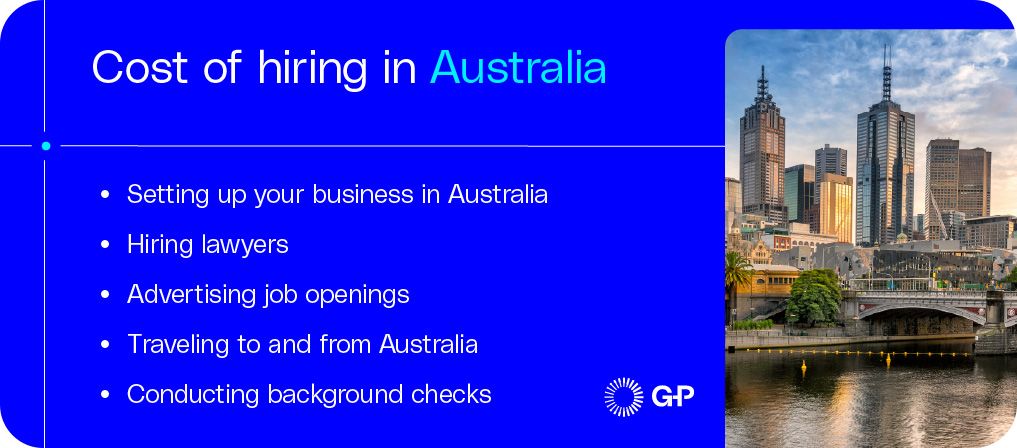
Whether you’re hiring one employee or an entire team in Australia, expenses are inevitable. Budget for the following:
-
Establishing your business in Australia: Legally establishing a business in Australia involves incorporation and registration costs. If you’re setting up a physical office, this will add to your costs as well.
-
Hiring lawyers: Since employment laws can get complicated in Australia, it’s wise to hire legal professionals to stay compliant during hiring and employment.
-
Advertising your job vacancies: Posting your job ad on job boards can cost you, though there are free options. The Australian government hosts an online job board where you can share your ad for free.
-
Traveling to and from Australia: If your company is sending representatives to Australia to establish your business or conduct interviews, you should also plan for these travel costs.
-
Conducting background checks: An important part of the pre-employment process is screening new hires to ensure their citizenship or visa, work history, references, or other aspects of their application are valid. Consider hiring an accredited company to conduct a police check for any relevant criminal histories.
According to G-P Verified Sources from Gia, the employer burden rate in Australia, which includes costs triggered on top of salaries, is 12%. The employee’s compensation insurance premium and payroll tax may increase the employer burden rate.
What does a company need to hire employees in Australia?
Make sure you cover these essentials before expanding your team in Australia:
-
Set up a branch or subsidiary: Unless you work with an Employer of Record (EOR), you’ll need to set up an entity in Australia. You can establish a branch or create a subsidiary and incorporate with the Australian Securities and Investments Commission (ASIC). Keep in mind that a subsidiary in Australia must have at least one director residing in the country.
-
Complete GST and PAYG registrations: Register for PAYG withholding tax to start payroll. You also need to register for the Goods and Services Tax (GST).
-
Set up an Australian bank account: Opening bank accounts in the country is critical for payroll and conducting business in Australia. Branch offices may be able to share finances with the parent country.
-
Obtain licenses and permits: Depending on the region, the industry, and your business activities, you may need to obtain licenses or permits.
Use G-P EOR to hire full-time employees in Australia without setting up your own entity. Build your team in Australia at a lower cost and with peace of mind that you’re doing so compliantly.
Steps to hiring in Australia
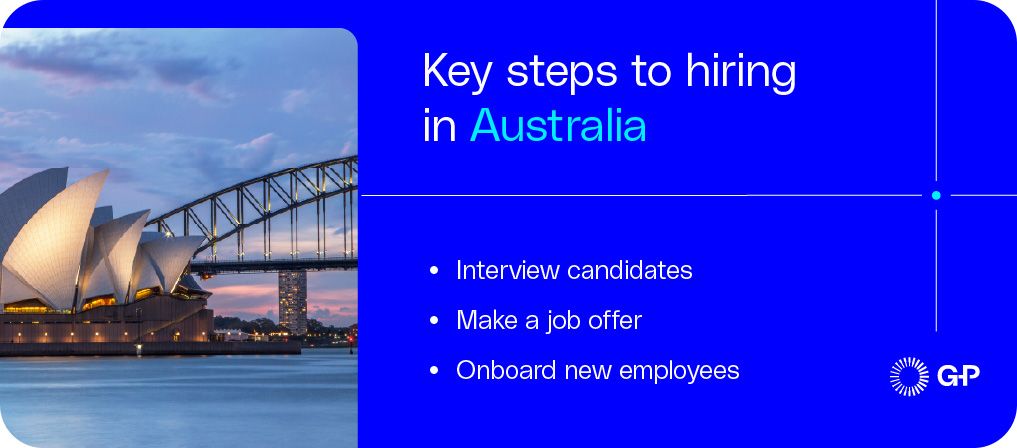
The hiring process in Australia is similar to the one you’re likely familiar with in your own country. The hiring process follows five basic steps: advertising the job, evaluating applications, interviewing candidates, sending job offers, and onboarding new employees.
1. Advertise job vacancies
First, you need to create a detailed job description for your vacancies in Australia. Include important information, such as the qualities you’re looking for in a candidate, the job duties, and any technical skills needed for the role. Post your job ads on online job boards where job seekers in Australia will see them. In addition to general job boards, you can also use industry-specific sites to advertise your job vacancies.
2. Evaluate applications
Once job seekers apply for your new positions, evaluate their applications and determine which candidates are the best fit for the position. You can include skills tests or questionnaires in your application to learn more about candidates’ qualifications.
You can expect resumes or CVs to be around two to three pages in Australia. Australian resumes outline the candidate’s work experience, education, skills, and may also include the applicant’s hobbies or interests.
3. Interview candidates
Next, interview candidates who made it onto your shortlist. You can conduct interviews virtually or in person if you have a branch or subsidiary set up. Phone or video interviews are especially helpful if you’re hiring remote employees in Australia and want to avoid traveling there.
Factor in the time difference for interviewees. There are five time zones in Australia’s mainland states and territories. This can be challenging for businesses in faraway countries. For example, a business headquartered in Toronto is 13.5 hours behind Australian Central Standard Time. The company would need to schedule interviews early in the morning to catch interviewees in the late evening.
4. Make job offers
Now it’s time to contact your chosen candidate to offer them a position with your company. Give them the opportunity to ask questions and negotiate their salary or other terms if necessary.
You can also draft an employment contract. However, you must abide by any requirements laid out in an award if applicable. You can also create an enterprise agreement with new employees if this helps you develop terms that are appropriate for your company, but these terms can’t undercut award requirements.
5. Onboard new employees
Now you can onboard new employees. Have them fill out all the necessary paperwork to establish payroll and add them to your company’s internal systems. If you’re working with an EOR like G-P, you won’t have to worry about the administrative burden of onboarding. We’ll streamline the process, so you can focus on training your new hire and integrating them into your company culture.
Hiring contractors in Australia
Working with independent contractors in Australia can be a cost-effective way to test the market and build a presence without the commitment of full-time employees. Contractors based in Australia understand local consumer behavior, rules, and business practices. They’ll be ready to start working quickly with their own equipment and established work processes.
Hiring contractors allows you to easily adjust your workforce based on your business needs, without the complexities and costs of employment.
Before you enter an agreement with an independent contractor in Australia, consider the following:
1. Employees vs. independent contractors
It’s important to understand the difference between employees and independent contractors . In Australia, employers hire employees to do work and, in return, pay them a regular salary and benefits. Independent contractors provide services. Unlike employees, contractors set their schedules, use their own equipment, and work on specific projects rather than having an ongoing role.
2. Penalties for misclassification
Classifying someone as a contractor when they are not can lead to severe penalties. If misclassification occurs, you may need to:
-
Pay all withholding taxes for the time the person was employed.
-
Provide back pay for superannuation contributions, including interest.
-
Face heavy fines if your company is found to be intentionally misleading.
3. How to pay contractors in Australia
G-P Contractor ™ takes away the messy, time-consuming process of hiring and paying international contractors. You can create and issue contracts and pay contractors with just a few clicks, all while ensuring a compliant process.
Hire employees and contractors in Australia with G-P
Our SaaS and AI-powered products – EOR , Contractor , and Gia – help companies of all sizes build and manage global teams.
With more than a decade of experience, the largest team of HR, legal, and compliance experts, and a global proprietary knowledge base, G-P is the recognized leader in global employment .
Make your expansion to Australia easier with G-P. Contact us or book a demo today.



